Abstract
The effect of DSCG on human IgE production in vitro was studied. DSCG selectively inhibited interleukin-4 (IL-4) induced IgE production by mononuclear cells (MNC) from normal donors without affecting IgM, IgA, IgG1, IgG2 or IgG3 production. In contrast, DSCG enhanced IgG4 production. To achieve this effect, DSCG must be added to the culture at the initiation and be present throughout the entire culture period. Interferon-gamma (IFN-gamma) also inhibited IL-4-induced IgE production, but IgG4 production was not affected by IFN-gamma. Monoclonal anti-IFN-gamma antibody blocked the inhibition of IgE production by IFN-gamma, but did not block the inhibition of IgE production by DSCG. DSCG also selectively inhibited spontaneous IgE production and enhanced IgG4 production by B cells from atopic patients in the presence of T cells and monocytes. These results indicate that there is a mechanism of IgE production inhibition which is not mediated by IFN-gamma. We also found that DSCG is an excellent reagent for the study of IgE and IgG4 regulation in vitro.
Full text
PDF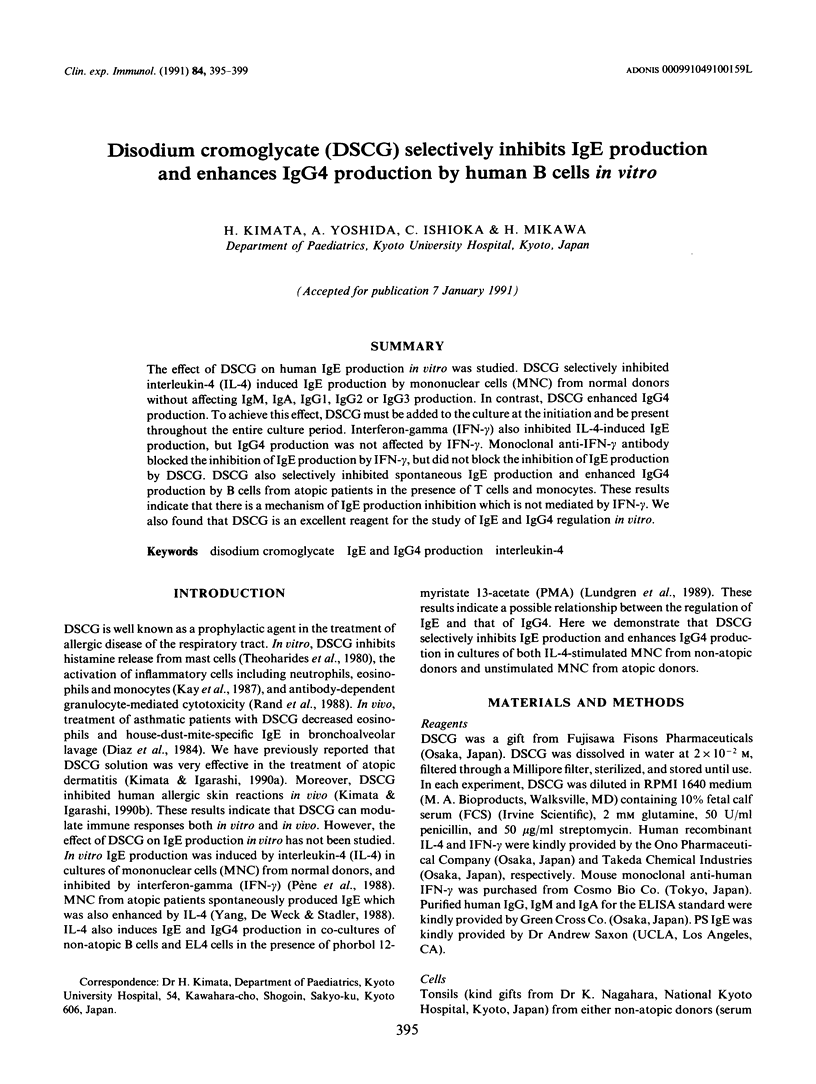
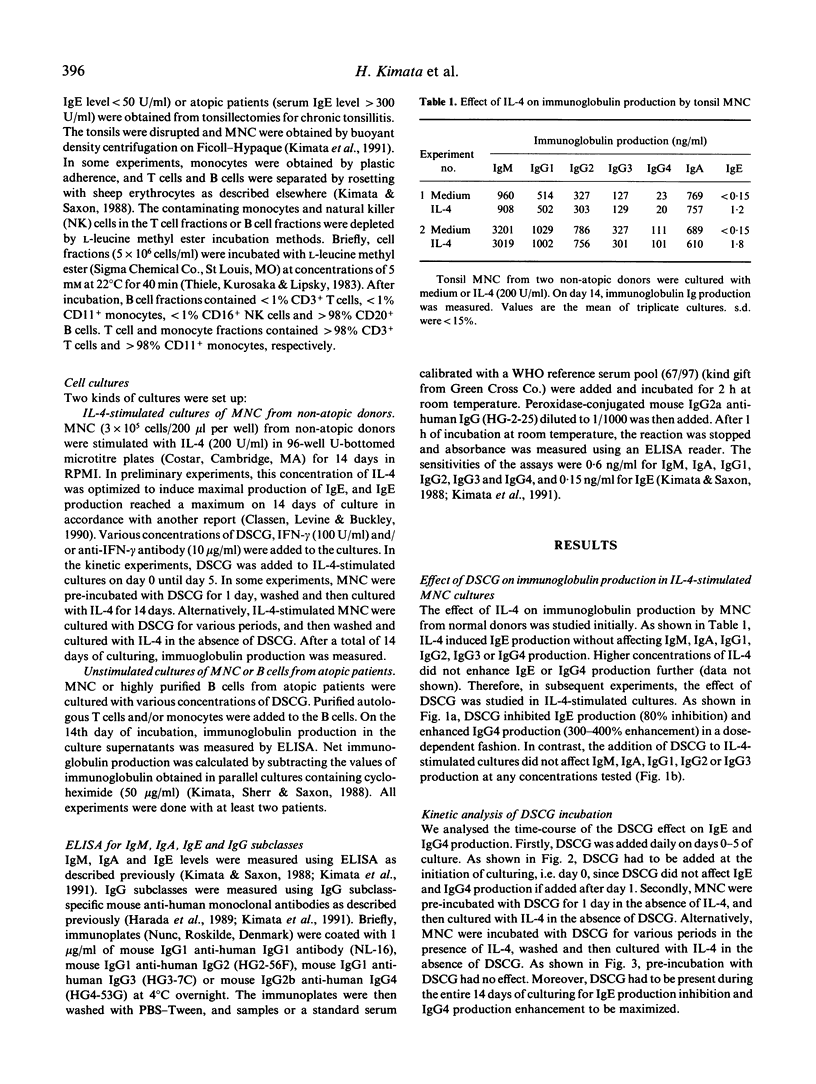
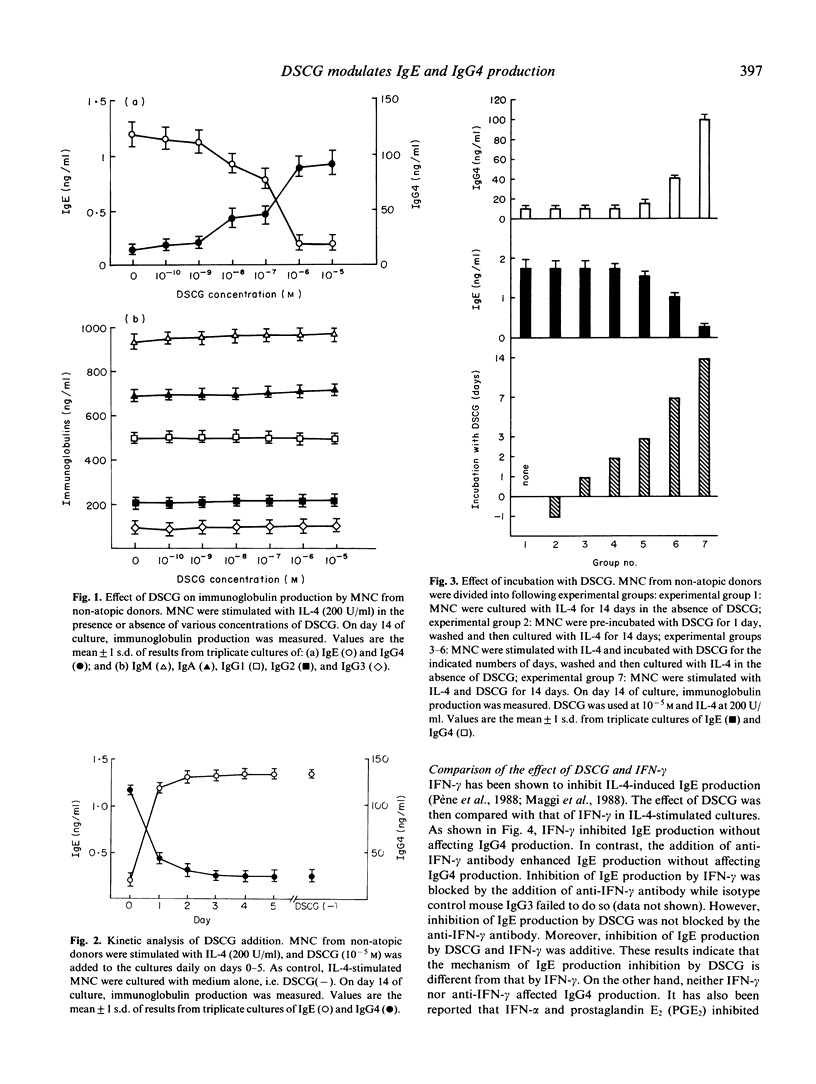
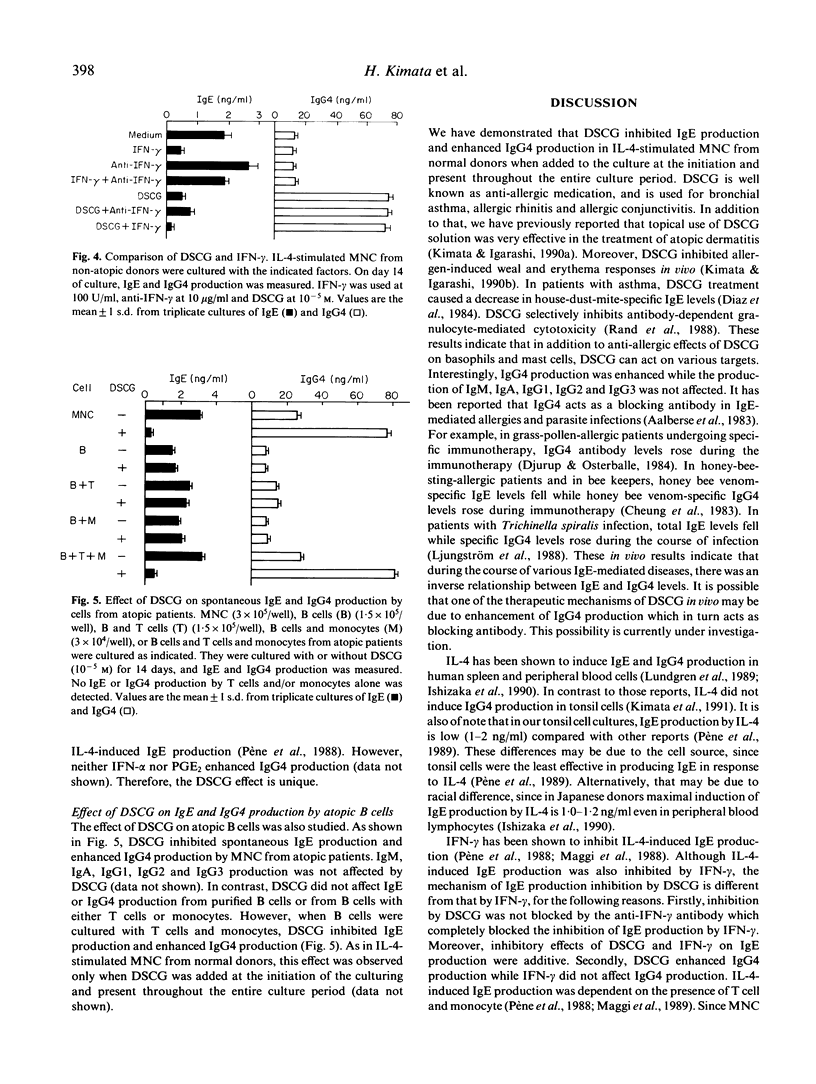
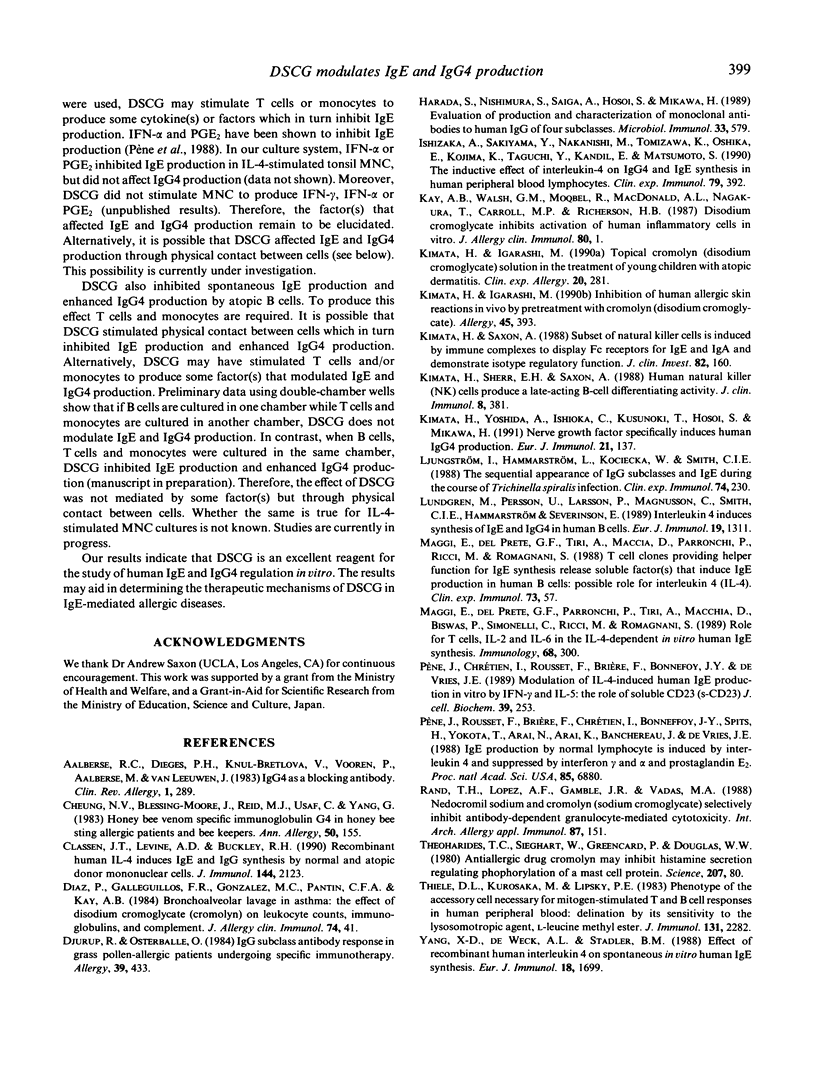
Selected References
These references are in PubMed. This may not be the complete list of references from this article.
- Aalberse R. C., Dieges P. H., Knul-Bretlova V., Vooren P., Aalbers M., van Leeuwen J. IgG4 as a blocking antibody. Clin Rev Allergy. 1983 Jun;1(2):289–302. doi: 10.1007/BF02991163. [DOI] [PubMed] [Google Scholar]
- Cheung N. K., Blessing-Moore J., Reid M. J., Yang G. Honey bee venom specific immunoglobulin G4 in honey bee sting allergic patients and bee keepers. Ann Allergy. 1983 Mar;50(3):155–160. [PubMed] [Google Scholar]
- Claassen J. L., Levine A. D., Buckley R. H. Recombinant human IL-4 induces IgE and IgG synthesis by normal and atopic donor mononuclear cells. Similar dose response, time course, requirement for T cells, and effect of pokeweed mitogen. J Immunol. 1990 Mar 15;144(6):2123–2130. [PubMed] [Google Scholar]
- Diaz P., Galleguillos F. R., Gonzalez M. C., Pantin C. F., Kay A. B. Bronchoalveolar lavage in asthma: the effect of disodium cromoglycate (cromolyn) on leukocyte counts, immunoglobulins, and complement. J Allergy Clin Immunol. 1984 Jul;74(1):41–48. doi: 10.1016/0091-6749(84)90085-x. [DOI] [PubMed] [Google Scholar]
- Djurup R., Osterballe O. IgG subclass antibody response in grass pollen-allergic patients undergoing specific immunotherapy. Prognostic value of serum IgG subclass antibody levels early in immunotherapy. Allergy. 1984 Aug;39(6):433–441. doi: 10.1111/j.1398-9995.1984.tb01965.x. [DOI] [PubMed] [Google Scholar]
- Harada S., Nishimura S., Saiga A., Hosoi S., Mikawa H. Evaluation of production and characterization of monoclonal antibodies to human IgG of four subclasses. Microbiol Immunol. 1989;33(7):579–592. doi: 10.1111/j.1348-0421.1989.tb02008.x. [DOI] [PubMed] [Google Scholar]
- Ishizaka A., Sakiyama Y., Nakanishi M., Tomizawa K., Oshika E., Kojima K., Taguchi Y., Kandil E., Matsumoto S. The inductive effect of interleukin-4 on IgG4 and IgE synthesis in human peripheral blood lymphocytes. Clin Exp Immunol. 1990 Mar;79(3):392–396. doi: 10.1111/j.1365-2249.1990.tb08101.x. [DOI] [PMC free article] [PubMed] [Google Scholar]
- Kay A. B., Walsh G. M., Moqbel R., MacDonald A. J., Nagakura T., Carroll M. P., Richerson H. B. Disodium cromoglycate inhibits activation of human inflammatory cells in vitro. J Allergy Clin Immunol. 1987 Jul;80(1):1–8. doi: 10.1016/s0091-6749(87)80183-5. [DOI] [PubMed] [Google Scholar]
- Kimata H., Igarashi M. Inhibition of human allergic skin reactions in vivo by pretreatment with cromolyn (disodium cromoglycate). Allergy. 1990 Jul;45(5):393–395. doi: 10.1111/j.1398-9995.1990.tb00517.x. [DOI] [PubMed] [Google Scholar]
- Kimata H., Igarashi M. Topical cromolyn (disodium cromoglycate) solution in the treatment of young children with atopic dermatitis. Clin Exp Allergy. 1990 May;20(3):281–283. doi: 10.1111/j.1365-2222.1990.tb02684.x. [DOI] [PubMed] [Google Scholar]
- Kimata H., Saxon A. Subset of natural killer cells is induced by immune complexes to display Fc receptors for IgE and IgA and demonstrates isotype regulatory function. J Clin Invest. 1988 Jul;82(1):160–167. doi: 10.1172/JCI113565. [DOI] [PMC free article] [PubMed] [Google Scholar]
- Kimata H., Sherr E. H., Saxon A. Human natural killer (NK) cells produce a late-acting B-cell differentiation activity. J Clin Immunol. 1988 Sep;8(5):381–389. doi: 10.1007/BF00917154. [DOI] [PubMed] [Google Scholar]
- Kimata H., Yoshida A., Ishioka C., Kusunoki T., Hosoi S., Mikawa H. Nerve growth factor specifically induces human IgG4 production. Eur J Immunol. 1991 Jan;21(1):137–141. doi: 10.1002/eji.1830210121. [DOI] [PubMed] [Google Scholar]
- Ljungström I., Hammarström L., Kociecka W., Smith C. I. The sequential appearance of IgG subclasses and IgE during the course of Trichinella spiralis infection. Clin Exp Immunol. 1988 Nov;74(2):230–235. [PMC free article] [PubMed] [Google Scholar]
- Maggi E., Del Prete G. F., Parronchi P., Tiri A., Macchia D., Biswas P., Simonelli C., Ricci M., Romagnani S. Role for T cells, IL-2 and IL-6 in the IL-4-dependent in vitro human IgE synthesis. Immunology. 1989 Nov;68(3):300–306. [PMC free article] [PubMed] [Google Scholar]
- Maggi E., Del Prete G. F., Tiri A., Macchia D., Parronchi P., Ricci M., Romagnani S. T cell clones providing helper function for IgE synthesis release soluble factor(s) that induce IgE production in human B cells: possible role for interleukin 4 (IL-4). Clin Exp Immunol. 1988 Jul;73(1):57–62. [PMC free article] [PubMed] [Google Scholar]
- Pène J., Chrétien I., Rousset F., Brière F., Bonnefoy J. Y., de Vries J. E. Modulation of IL-4-induced human IgE production in vitro by IFN-gamma and IL-5: the role of soluble CD23 (s-CD23). J Cell Biochem. 1989 Mar;39(3):253–264. doi: 10.1002/jcb.240390305. [DOI] [PubMed] [Google Scholar]
- Pène J., Rousset F., Brière F., Chrétien I., Bonnefoy J. Y., Spits H., Yokota T., Arai N., Arai K., Banchereau J. IgE production by normal human lymphocytes is induced by interleukin 4 and suppressed by interferons gamma and alpha and prostaglandin E2. Proc Natl Acad Sci U S A. 1988 Sep;85(18):6880–6884. doi: 10.1073/pnas.85.18.6880. [DOI] [PMC free article] [PubMed] [Google Scholar]
- Rand T. H., Lopez A. F., Gamble J. R., Vadas M. A. Nedocromil sodium and cromolyn (sodium cromoglycate) selectively inhibit antibody-dependent granulocyte-mediated cytotoxicity. Int Arch Allergy Appl Immunol. 1988;87(2):151–158. doi: 10.1159/000234665. [DOI] [PubMed] [Google Scholar]
- Theoharides T. C., Sieghart W., Greengard P., Douglas W. W. Antiallergic drug cromolyn may inhibit histamine secretion by regulating phosphorylation of a mast cell protein. Science. 1980 Jan 4;207(4426):80–82. doi: 10.1126/science.6153130. [DOI] [PubMed] [Google Scholar]
- Thiele D. L., Kurosaka M., Lipsky P. E. Phenotype of the accessory cell necessary for mitogen-stimulated T and B cell responses in human peripheral blood: delineation by its sensitivity to the lysosomotropic agent, L-leucine methyl ester. J Immunol. 1983 Nov;131(5):2282–2290. [PubMed] [Google Scholar]
- Yang X. D., De Weck A. L., Stadler B. M. Effect of recombinant human interleukin 4 on spontaneous in vitro human IgE synthesis. Eur J Immunol. 1988 Nov;18(11):1699–1704. doi: 10.1002/eji.1830181107. [DOI] [PubMed] [Google Scholar]


